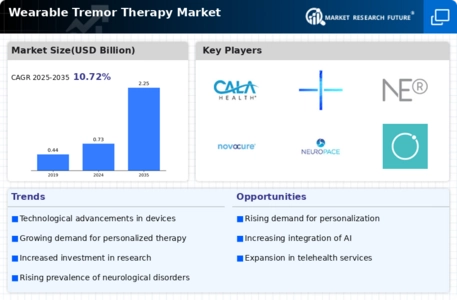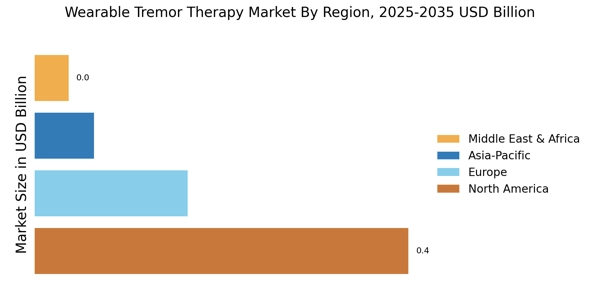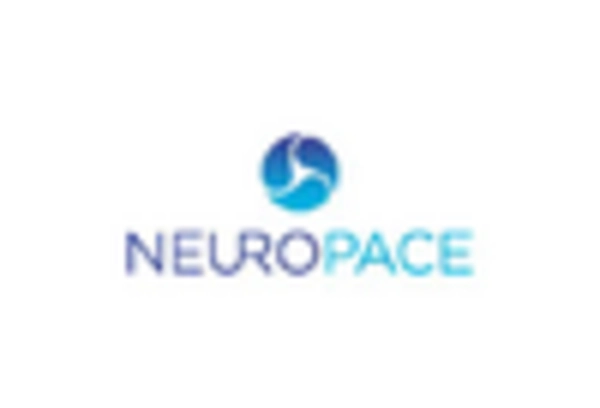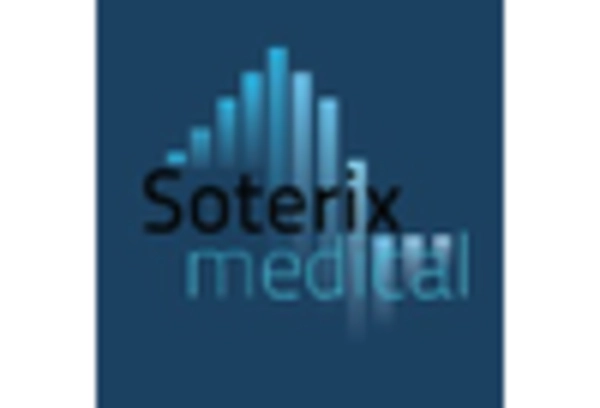Integration with Telehealth Services
The integration of wearable tremor therapy devices with telehealth services represents a significant driver for the Wearable Tremor Therapy Market. As healthcare systems increasingly adopt telehealth solutions, the ability to remotely monitor patients' tremor conditions becomes more feasible. This integration allows healthcare providers to offer personalized care plans and adjust treatments based on real-time data collected from wearable devices. The convenience and accessibility of telehealth services enhance patient engagement and adherence to therapy, which is crucial for effective tremor management. Consequently, the Wearable Tremor Therapy Market is poised for growth as more healthcare providers recognize the value of combining wearable technology with telehealth capabilities.
Rising Prevalence of Neurological Disorders
The increasing incidence of neurological disorders, particularly essential tremor and Parkinson's disease, drives the demand for innovative solutions in the Wearable Tremor Therapy Market. According to recent estimates, essential tremor affects approximately 0.4 to 6% of the population, with a notable rise in cases among the aging demographic. This growing patient population necessitates effective management strategies, thereby propelling the development and adoption of wearable devices designed to alleviate tremors. As healthcare systems seek to improve patient outcomes, the Wearable Tremor Therapy Market is likely to expand, offering new therapeutic options that enhance the quality of life for individuals suffering from these conditions.
Increased Investment in Healthcare Technology
The surge in investment in healthcare technology is a critical factor propelling the Wearable Tremor Therapy Market. Venture capital and private equity firms are increasingly funding startups and established companies focused on developing innovative wearable solutions for tremor management. This influx of capital enables research and development efforts to accelerate, leading to the introduction of advanced wearable devices that cater to the needs of patients with tremors. Furthermore, government initiatives aimed at promoting health technology innovation contribute to this trend, creating a favorable environment for the Wearable Tremor Therapy Market to thrive. As investment continues to grow, the market is likely to expand, offering a wider array of therapeutic options for individuals affected by tremors.
Technological Innovations in Wearable Devices
Technological advancements play a pivotal role in shaping the Wearable Tremor Therapy Market. Innovations such as miniaturized sensors, advanced algorithms, and machine learning capabilities enable the creation of more effective and user-friendly wearable devices. These devices not only monitor tremor severity but also provide real-time feedback and personalized therapy options. The integration of artificial intelligence into wearable technology enhances the precision of tremor management, making it a compelling choice for patients and healthcare providers alike. As these technologies continue to evolve, the Wearable Tremor Therapy Market is expected to witness substantial growth, driven by the demand for cutting-edge solutions that address the complexities of tremor disorders.
Growing Awareness and Acceptance of Wearable Health Technologies
The increasing awareness and acceptance of wearable health technologies significantly influence the Wearable Tremor Therapy Market. Patients and healthcare professionals are becoming more informed about the benefits of wearable devices in managing health conditions, including tremors. This shift in perception is supported by educational initiatives and marketing efforts that highlight the advantages of using wearables for real-time monitoring and therapy. As a result, the adoption rate of wearable tremor therapy solutions is likely to rise, fostering a more robust market environment. The Wearable Tremor Therapy Market stands to benefit from this trend, as more individuals seek out innovative solutions to manage their symptoms effectively.


















Leave a Comment